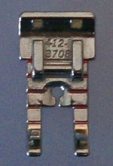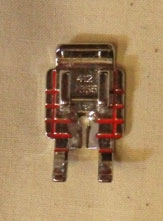This post contains affiliate links for which I receive compensation
1/4 patchwork presser foot
by Miriam
(Manchester, Connecticut)
Miriam writes...
I have a really hard time maintaining a 1/4 inch seam on my patchwork.I'm looking at special feet for my machine that will help guide me, but there are a couple of different kinds.
What's the difference?
Which one is better?
Julie replies...

Both the left and right edges of the foot are a quarter inch from the needle.
Note the faint red markings on both the left and right edges of this foot. These mark 1/8 and 1/4 inch in front of and behind the needle.
Because of the small hole for your needle, you must use the 'center' needle position for this foot. Furthermore, you can use your straight stitch throat plate with the centered needle. (Personally, I think you get a better stitch with this particular throat plate.)
The video below shows Bernina's version of this foot (Patchwork Foot #37) in action.
Many of my friends use this type of quarter inch foot and love it.
I do not.
I never feel comfortable that I've got the foot exactly even with the cut edge of my fabric. (I'm farsignted and am known for wearing two pairs of glasses when I'm quilting—one prescription, one reading to magnify what I'm doing...there I've admitted my little secret!)
Lots of time I'm 'sneaking' downstairs to my machine to snitch a bit of sewing time...it's not the best environment for accurate stitching.
I'm also known for continuing to sew until I can't see straight, my eyes are just too tired. But I love quilting and sometimes just can't stop myself.
So I switched feet...to something that works better for how I piece...
My favorite presser foot for piecing is...

Bernina calls their version 'Patchwork Foot with guide #57'. (The important part of the name is 'guide'.)
What I like about the foot is the guide blade or flange on the right hand side of the foot.
To stitch a perfect quarter inch seam, just guide the cut edges of your seam allowance along the metal guide.
I have to adjust my needle position because the right edge of the foot is further than 1/4 inch away from a center positioned needle. (Check the instructions for your foot to see if you need to do this.)
The following Bernina video shows this foot in action...
One of the benefits is that the foot uses the entire surface of the feed dogs to guide your fabric through the machine. (Take a look again at the first video and you'll see the feed dogs peeking out from underneath the foot.)
Another is that you can fine-tune your quarter inch seam allowance for different fabric thicknesses by adjusting the needle position. I do use a different position for when I use flannel or homespun fabrics.
Because you change needle positions, you will need to use your regular zig zag throatplate with the oval hole. This is the one that comes with most machines.
Personally, I like to starch (heavily) my quilt fabric. This foot makes accurate piecing so much easier for me...even when I'm too tired or distracted to do as good a job as I should. See my page Starch Quilt Fabric to learn more.
Watch out for pins...
To accommodate the pins used for piecing, insert your pins so the heads are on the left, or...My sewing machine allows me to select to have it stop with the needle down in the fabric. When I do, the presser foot raises just a bit. As I reach a pin (with the head to the right) I stop the machine. The needle ends down in the fabric, the presser foot raises. I then set the foot and flange/guide down on top of the pin and keep sewing.
Yes, yes, I know I'm not supposed to sew over pins and I don't advocate it because it can mess up your machine's timing (not to mention flying broken needles). But I piece with extremely fine pins and this is what works for me.
Miriam, I hope this helps you in your search for the perfect 1/4 patchwork piecing foot for you!
Readers, what do you think? Do you have a favorite piecing foot. Do tell us about it using the 'Comment' link just below.
Thank you.
Piecefully,
Julie Baird
Editor
Comments for 1/4 patchwork presser foot
|
||
|
||
|
||
|
||
|
||
|
||
















